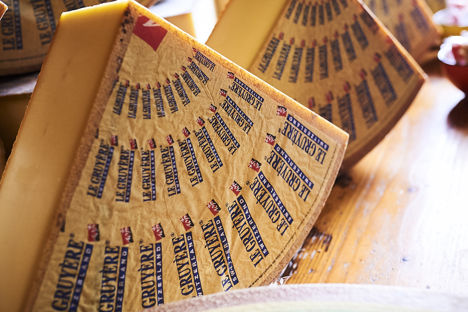
Gruyère AOP: not just for melting
The thought of Gruyère AOP conjures images of fondue and Croque Monsieur, but not all Gruyère AOPs are created equal – as Gruyère AOP ages, it takes on a decidedly different flavour and texture. Find out more about the different classifications of Gruyère AOP before you go in search of the right cheese for you.
Gruyère AOP: not just for melting
The thought of Gruyère AOP conjures images of fondue and Croque Monsieur, but not all Gruyère AOPs are created equal – as Gruyère AOP ages, it takes on a decidedly different flavour and texture. Find out more about the different classifications of Gruyère AOP before you go in search of the right cheese for you.
When it comes to tasty, versatile cheeses that always find a way into our shopping basket, Gruyère AOP always seems to come top of the pile. It really does all you could ask of a cheese – it’s delicious sliced into sandwiches or as part of a cheeseboard, grilled over the top of a Croque Monsieur, or melted into a French onion soup or a silky fondue. Gruyère AOP boasts a nutty, complex flavour that makes it adaptable to all sorts of different recipes and styles of cooking.
That said, not all Gruyère AOPs are the same. The alpine cheese starts life as a young, creamy, pale yellow cheese with a nutty flavour, but as it gets older, the flavours become more assertive and complex, and the texture firms up, becoming grainy and crumbly. Most Gruyère AOP you see in the shops is around six months old – at this age the cheese still displays a youthful character, both in terms of its sweet, mellow flavour and soft texture. Young Gruyère AOP is perfect for dishes like fondue and Croque Monsieur; cheeses melt well when they have a high water content and cheeses also dry out as they age – as a result, you’re best off with a young Gruyère AOP if you’re planning on melting it down.
Older Gruyère AOPs have a much more intense flavour, but they are still recognisable as the same cheese. The crumbly nature of the cheese makes it excellent for seasoning dishes and it stands up extremely well on a cheeseboard alongside a chutney and some fresh fruit. It can also be used in sauces and the like – aged Gruyère AOP will still melt, it just may not melt quite as readily as the less-aged version.
If you’re buying Gruyère AOP in Switzerland, keep an eye out for terms like doux (at least five months old), réserve or surchoix (at least ten months old), mi-salé (between seven and eight months old), salé (nine to ten months old), vieux (fourteen months old), and Höhlengereift (cave-aged) to give you an idea of what you’re buying.
Also bear in mind that not all Gruyère is Gruyère AOP. Only Gruyère made using traditional methods – the same methods used for nearly 1,000 years – in and around the Swiss canton of Fribourg can be marked as Gruyère AOP. Gruyère AOP is the true taste of Gruyère, and there are a few different types of Gruyère AOP to keep an eye out for.
As the name suggests, this is the classic Gruyère AOP – sweet and nutty, with a soft, malleable texture and small, distinctive holes throughout the cheese. Gruyère AOP Classic can be aged anywhere between six and nine months and cheeses will intensify in flavour over the course of that time, so it’s worth checking how old the cheese is or tasting it first. Again, this is the perfect cheese if you’re putting together one of the classic Gruyère AOP dishes – a fondue or a Croque Monsieur, for example.
The Réserve moniker on a piece of Gruyère AOP means that this piece of cheese is at least ten months old. Look at it alongside a piece of Gruyère AOP Classic and you’ll see the Réserve is noticeably darker – as the cheese matures and dries slightly, the yellow colour intensifies, as does the flavour. The texture is firmer and crumblier, with clear graining and some calcium crystals spread throughout. This is a deeply complex cheese, best appreciated on its own with a suitable glass of wine, but it is equally delicious when used as a seasoning for other dishes, or melted into sauces.
Gruyère AOP Bio is almost identical to Gruyère AOP Classic in flavour and texture – it’s aged between six and nine months, so tends to have a similar young flavour profile and a soft texture. The only difference is the ‘Bio’ moniker, which means that this Gruyère AOP is made only with milk that comes from Bio Suisse regulated farms (the equivalent of organic regulations in the UK).
Produced exclusively between May and October, Gruyère d'Alpage AOP is a perfect display of the deep complexity that Gruyère develops when aged. The name ‘d'Alpage’ refers to the geographical area that this cheese comes from, specifically the alpine area around Gruyères, Jura and the French-Swiss border. When cattle graze on these summer alpine pastures it gives their milk a particularly rich flavour, which results in Gruyère d'Alpage AOP – a cheese that has rich, fruity and spicy notes when aged.


